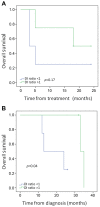Yttrium-90 radioembolization for colorectal cancer liver metastases in KRAS wild-type and mutant patients: Clinical and ccfDNA studies
- PMID: 28004119
- PMCID: PMC5355723
- DOI: 10.3892/or.2016.5284
Yttrium-90 radioembolization for colorectal cancer liver metastases in KRAS wild-type and mutant patients: Clinical and ccfDNA studies
Abstract
Patients with unresectable, chemo-refractory colorectal cancer liver metastases (CRCLM) have limited local treatment options. We report our institutional experience on the efficacy of resin-based yttrium-90 (90Y) radioembolization for the treatment of CRCLM and our findings on associated circulating cell-free DNA (ccfDNA) studies. A total of 58 patients treated with 90Y for CRCLM at the Medstar Georgetown University Hospital had a median survival of 6 months [95% confidence interval (CI), 4.55‑7.45 months] after treatment, with a 12-month survival rate of 33%. The median survival from treatment stratified by mutational status was longer in the wild-type (WT) as compared to the KRAS mutant patients at 7 vs. 5 months, but did not achieve statistical significance (p=0.059). Median tumor local control duration after 90Y treatment was 2 months (95% CI, 0.34‑3.66 months) for the entire cohort and was longer in the WT vs. the mutant patients (2 vs. 1 month, respectively, p=0.088). Plasma was prospectively collected from a subset of 9 patients both before and after single lobe treatment, and ccfDNA concentration and fragmentation index (FI) were measured using quantitative PCR and atomic-force microscopy (AFM). In the WT and KRAS mutant patients, DNA FI was reduced from a median of 0.73-0.65 after treatment. A reduction in DNA FI after single lobe treatment was associated with an improved overall survival (p=0.046). Analysis by AFM of paired pre- and post-treatment samples from KRAS mutant and WT patients revealed a larger average decrease in fragment size in the WT patients (p=0.013). 90Y radioembolization extends local control for CRCLM, however, KRAS mutant tumors may be more radio-resistant to treatment. Changes in the FI of patients following treatment were noted and may be evaluated in a larger study for relevance as a biomarker of response.
Figures






Similar articles
-
KRAS Status as an Independent Prognostic Factor for Survival after Yttrium-90 Radioembolization Therapy for Unresectable Colorectal Cancer Liver Metastases.J Vasc Interv Radiol. 2015 Aug;26(8):1102-11. doi: 10.1016/j.jvir.2015.05.032. J Vasc Interv Radiol. 2015. PMID: 26210240 Clinical Trial.
-
Is yttrium-90 radioembolization a viable treatment option for unresectable, chemorefractory colorectal cancer liver metastases? A large single-center experience of 302 patients.Ann Surg Oncol. 2015 Mar;22(3):794-802. doi: 10.1245/s10434-014-4164-x. Epub 2014 Oct 17. Ann Surg Oncol. 2015. PMID: 25323474 Clinical Trial.
-
Connecting cancer biology and clinical outcomes to imaging in KRAS mutant and wild-type colorectal cancer liver tumors following selective internal radiation therapy with yttrium-90.Abdom Radiol (NY). 2017 Feb;42(2):451-459. doi: 10.1007/s00261-016-0875-8. Abdom Radiol (NY). 2017. PMID: 27600383
-
Radioembolization as a Treatment Strategy for Metastatic Colorectal Cancer to the Liver: What Can We Learn from the SIRFLOX Trial?Curr Treat Options Oncol. 2016 Jun;17(6):26. doi: 10.1007/s11864-016-0402-8. Curr Treat Options Oncol. 2016. PMID: 27098532 Review.
-
Evidence-Based Integration of Yttrium-90 Radioembolization in the Contemporary Management of Hepatic Metastases from Colorectal Cancer.Tech Vasc Interv Radiol. 2019 Jun;22(2):74-80. doi: 10.1053/j.tvir.2019.02.007. Epub 2019 Feb 27. Tech Vasc Interv Radiol. 2019. PMID: 31079714 Review.
Cited by
-
Personalized Therapy and Liquid Biopsy-A Focus on Colorectal Cancer.J Pers Med. 2021 Jul 1;11(7):630. doi: 10.3390/jpm11070630. J Pers Med. 2021. PMID: 34357097 Free PMC article. Review.
-
Circulating DNA in patients undergoing loco-regional treatment of colorectal cancer metastases: a systematic review and meta-analysis.Ther Adv Med Oncol. 2022 Nov 2;14:17588359221133171. doi: 10.1177/17588359221133171. eCollection 2022. Ther Adv Med Oncol. 2022. PMID: 36339929 Free PMC article. Review.
-
Liver-Directed and Systemic Therapies for Colorectal Cancer Liver Metastases.Cardiovasc Intervent Radiol. 2019 Sep;42(9):1240-1254. doi: 10.1007/s00270-019-02284-9. Epub 2019 Jul 16. Cardiovasc Intervent Radiol. 2019. PMID: 31312902 Free PMC article.
-
Application of atomic force microscopy in cancer research.J Nanobiotechnology. 2018 Dec 11;16(1):102. doi: 10.1186/s12951-018-0428-0. J Nanobiotechnology. 2018. PMID: 30538002 Free PMC article. Review.
-
A Review on the Special Radiotherapy Techniques of Colorectal Cancer.Front Oncol. 2019 Apr 2;9:208. doi: 10.3389/fonc.2019.00208. eCollection 2019. Front Oncol. 2019. PMID: 31001474 Free PMC article. Review.
References
-
- Van Cutsem E, Nordlinger B, Adam R, Köhne CH, Pozzo C, Poston G, Ychou M, Rougier P. European Colorectal Metastases Treatment Group: Towards a pan-European consensus on the treatment of patients with colorectal liver metastases. Eur J Cancer. 2006;42:2212–2221. doi: 10.1016/j.ejca.2006.04.012. - DOI - PubMed
Publication types
MeSH terms
Substances
LinkOut - more resources
Full Text Sources
Other Literature Sources
Medical
Miscellaneous

